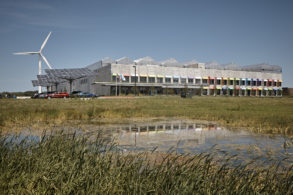
When people think about innovative infrastructure, they tend to think of massive tunnels, high speed rail, bridges, or highway projects, and while major transportation projects are certainly important components of our infrastructure spending, there is a lot more to the $300 billion worth of non-building projects put in place in the US, annually. Some of the most interesting illustrations of innovation in infrastructure relate to efforts that holistically approach the planning and development of the ecosystem of infrastructure for a neighborhood. Innovation in how we foster consensus around neighborhood development, creativity in financing, and extension of benefits beyond the most densely affluent areas are all places where new technology and thinking are finding root, and additionally, these neighborhood-oriented, mixed-use efforts offer some of the most interesting case studies for the design of our transportations, energy, data, water, waste, and open-space infrastructure.
When we meet at our Infrastructure Conference on the 12th and 13th of this month, we will be hosting a session with Comcast‘s Sean McCarthy, The Chicago Metropolitan Association for Planning’s, Erin Aleman, CBRE‘s Andria Winter, and Chicago Neighborhood Initiative‘s Ciere Boatright to look at innovative case studies of these kinds of mixed use neighborhoods around Chicago.
One of those neighborhoods is historic Pullman on Chicago’s South Side, a town built on 4,000 acres, back in 1880, to house the Pullman Palace Car Manufacturing company and to be a model mixed-use community for the company’s employees, providing them gas, water, sanitary, green space, and more. We looked at one project in the neighborhood back in 2015, when we first hosted our Project Innovation Talks.
Back in 2015, our attention centered on the Method Manufacturing building, billed as the first LEED Platinum manufacturing building. Karl Heitman of Heitman Architects, Adam Miller of Summit Design + Build, Jennifer Nelkin Frymark of Gotham Greens, and Scott Wiercinski and Arun Garg of KJWW Engineering Consultants walked us through the development. From an energy standpoint, we noted that building draws energy from both solar and wind infrastructure. We also noted that the building housed a 75,000-sf roof top agricultural greenhouse (The Sustainable Madness Behind Method Manufacturing’s New Facility 12.1.15) which could supply food to a nearby Whole Foods Distribution Center, among other places.
Method’s development, however, was only one part of the overall vision for a renewed Pullman. When we looked at Method, we also noted that Method was the first major development in what was conceived as a 180 acre industrial park. Today, as we prepare to meet with our panel, we note that the industrial component is almost completely built out. Method has recently announced an expansion of their building and also the Ryan Companies, recently announced a new Amazon Distribution Center in the park.
Beyond the industrial buildings, as we will hear on August 12th, the development at Pullman was about much more than an industrial park. Through the efforts of groups like the Chicago Neighborhood Initiatives and more than 80 meetings with residents (CNI Group Pullman Revitalization), goals for the area were established around access to jobs, groceries, and safe recreational spaces. As they thought about how to bring those goals to fruition, they harkened back to some of the original reasons for the region’s success. With proximity to Lake Calumet and its international port, major railroads and now to major highway systems as well, Pullman remains a valuable, strategically located logistics hub. Additionally, being 13 miles from Chicago downtown, and connected via rail, Pullman again sits on and by strategically valuable infrastructure. Beyond the critical infrastructure linking Pullman to the surrounding world, Pullman also benefitted from its system of parks and open spaces, linking the community with each other. In Pullman, we can simultaneously see evidence of just how long the benefits of carefully considered infrastructure planning can endure and also lessons about how to approach our infrastructure planning for the future.

Discussion
Be the first to leave a comment.
You must be a member of the BuiltWorlds community to join the discussion.